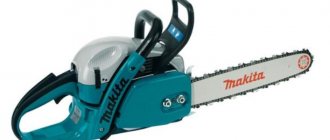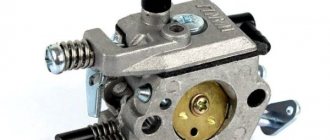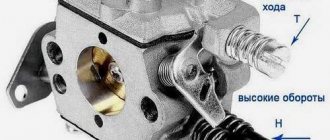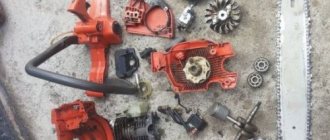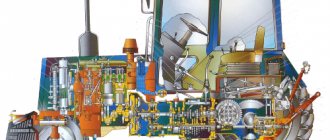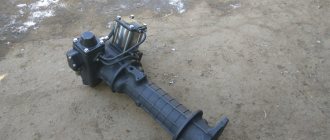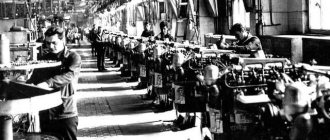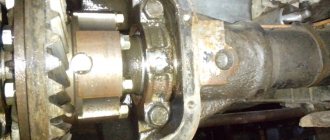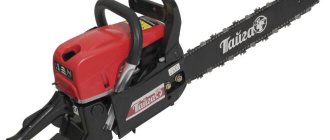How to find out if your lawn mower's carburetor needs adjustment
Many craftsmen use lawn mowers for a long time, and do not think about the need to adjust the carburetor of the tool. When is it necessary to adjust the carburetor on a lawn mower or brush cutter? If you are asking this question, then you are probably seeing changes in the operation of the engine that are not for the better. In order not to guess and not to miss the moment when it is necessary to adjust the carburetor, you should adhere to the following recommendations on the need for adjustment measures:
- After the engine has been run-in. Typically, running-in lasts for the duration of burning 4-5 liters of fuel.
- When a fuel mixture of a different composition is poured into the tank, that is, the type of oil (even its color) and the brand of gasoline change
- When weather conditions change, however, this is more relevant for chainsaws, gas generators and motor pumps, which are used not only in summer, but also in winter.
- If the lawn mower has not been used for a long time. The reason for the need for adjustment may be the winter break.
- When fuel consumption increases
- If black carbon deposits are detected on the spark plug electrodes
- If there is no gasoline entering the cylinder or the engine starts poorly
- If a large amount of exhaust gas is detected
- Unstable engine operation, as well as difficult starting and “sluggish” speed gain
As you can see, there are enough reasons to adjust the carburetor of a lawn mower. Typically, craftsmen who have been working with a tool for a long time can hear changes in the operation of the motor, which indicates the need for an adjustment process. Even if you are not sure about the need to carry out adjustment work, then performing it out of turn will definitely not be superfluous.
What is the problem with trimmer malfunction?
Champion lawn mower carburetor, how to adjust? This is a float-type trimmer - a common option designed to mix air and fuel in the prescribed proportions. The main problems that arise during engine operation are approximately similar to problems that occur with the carburetor in a car:
- The engine may stall immediately after it has been started. The reason is that there is not enough gasoline supplied. This is called "lean" fuel;
- Excessively supplied gasoline leads to incomplete combustion, excessive mixture density and uneconomical consumption.
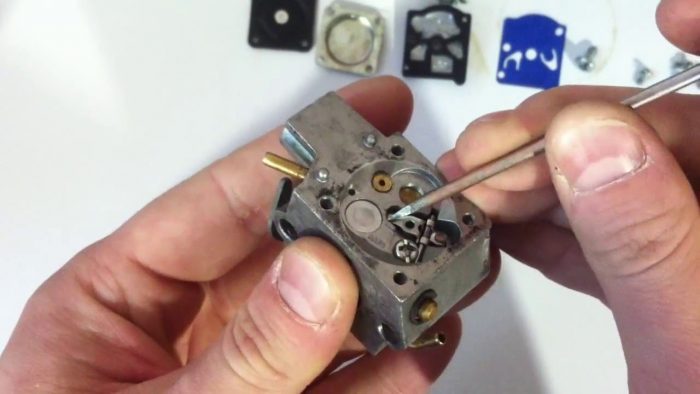
Carburetor repair
Important! The carburetor has to be adjusted under various circumstances: a change in temperature, fuel octane number or oil type, after winter or the end of the break-in period, load or spontaneous turning of the screws due to strong vibration of the body. Some owners prefer to tune the module before each use to ensure it is working correctly.
Starting the engine
The engine is started at a distance of 3 m or more from the place where the device is refueled. This work cannot be carried out indoors. Before you need to take a stable, reliable position. At the same time, the motorcycle device is held very tightly. The cutting tool should not come into contact with the ground or objects, because it may spin when started.
The unit is serviced by only one person; however, there should be no third parties in the area with a radius of up to 15 m. Otherwise, you may be injured by thrown objects. Starting the motor of the Shtil FS 55 lawn mower, the properties of which are presented in the article, should not be done by hand. After releasing the gas lever, the cutting tool will move for some time by inertia. Flammable materials should be kept away from the hot flow of gases and the surface of the hot muffler, because this may cause a fire.
Principle of operation
The procedure for pumping and filtering fuel into the lawn mower engine is as follows.
- The throttle valve controls the amount of air supplied to the diffuser. The more air supplied, the more oxygen the gasoline needs to burn, and the more power is released in the form of heat. The heat energy is further converted into mechanical energy.
- The diaphragm pump pumps the required amount of gasoline.
- Next, gasoline passes through the engine fitting.
- Fuel passes through the intake and exhaust valves.
- Fuel is filtered using a mesh filter.
- Through the needle valve, it enters the chamber with the membrane.
The stages of operation of the carburetor are as follows.
- The air enters the pipe with an air damper. The damper sets the desired air flow intensity.
- In the gasoline injection unit, the diffuser is narrowed - this is necessary to give greater air flow speed.
- The fuel passes through the compartment with the float and bypasses the nozzle and enters this narrowing of the tube. The float compartment meters the supply of gasoline. In this compartment the pressure is in a state of equilibrium. In a narrowed tube it decreases. Due to the difference between both pressure values, gasoline passes through the nozzle.
- The accelerated flow atomizes gasoline, converting it into aerosol vapor. The resulting gasoline-air mixture is ready for ignition in the combustion chamber.
- After passing through the fuel pipeline, this mixture ends up in the carburetor cylinder.
Conclusion: To set the required power, you will first adjust the rate of fuel combustion using the choke. If the gap is too small and the oxygen in such a mixture is less than 10%, the fuel does not burn, therefore, the engine will not start or will stall immediately.
If you buy a Chinese trimmer, it is worth considering that it differs little from European ones - the same 2- or 4-stroke engine and drive.
How to adjust the carburetor on a lawn mower
Before adjustment, the filters must be thoroughly cleaned according to the maintenance instructions.
Further adjustment of the lawn mower carburetor is done with your own hands using adjusting screws. There are three in total:
- right;
- left;
- lower.
Right (L) – adjusting the fuel mixture for low speeds.
You need to find the maximum idle speed. To do this, slowly turn the screw (L) to the right and left.
To adjust, turn the screw a quarter turn counterclockwise.
Lower (T) – is responsible for adjusting the engine at idle.
- clockwise – increase;
- counterclockwise – decrease.
For correct adjustment of idle speed it is typical:
- stable operation of a cold engine;
- not over-revving a hot engine;
- there is a large reserve of revolutions for the trimmer head;
- stable operation of the engine when changing position (sharp raising or lowering of the knife).
Left (H) – mixture adjustment at high speeds. (The screw is adjusted last).
Setting up the carburetor of a lawn mower with the last screw is done as follows:
- Open the throttle to full, while releasing full throttle. Turn the screw clockwise until the speed drops (in this case, use your ear).
- Turn the screw as slowly as possible counterclockwise until the engine runs rough.
- Then turn back just a little, barely hearing stable, smooth operation.
- For a more visual application of skills, it is more convenient to consider the work of an experienced user:
It is interesting that from the point of view of the author of the video, the setting (its correctness) is determined by the color of the spark plug, and not just by the engine speed and stability.
Correctly adjusting the carburetor with your own hands in this case means combustion of the fuel mixture without residue; the color of the spark plug should be light brown.
Spring can get in the way
My first attempt at adjusting the carburetor braid failed because the spring on the fuel mixture adjustment screw prevented it. The factory spring was too thick when compressed and did not allow the fuel flow to be reduced to the required level. I had to assemble another spring and continue making adjustments after replacing it.
READ What Oil to Fill in the Trimmer Engine
Spring adjusting screw
In the photo above. Factory spring, below the adjusting screw with the selected spring. I am writing about this because I am not sure if this is an isolated case and someone else may face the same situation.
The principle of operation of a lawn mower carburetor
The throttle valve determines the amount of air supplied, and the engine power directly depends on this.
Correct carburetor
determined by the operation of the motor and the color of the spark plug. Adjusted
Self-adjustment of the carburetor
on a Chinese trimmer, quickly and easily adjust
the carburetor
to
Fuel is sucked into the carburetor system by a pump (its membrane). Then it passes through the fitting in the carburetor. The liquid then moves through the inlet and outlet valves of the pump. Filtered with a mesh. It moves through the needle valve into the membrane chamber.
Step-by-step operation of the device:
- Air supply into a tube with an air baffle (damper). The partition regulates the intensity of the air flow.
- The fuel supply system is certainly narrowed by the mixer to speed up the flow.
- Gasoline through the float chamber and the nozzle tube with a narrowing. A chamber with a float regulates the temporary volume of gasoline. In the float chamber the pressure level is neutral, but in the tube with a narrowing it is already small. Due to the pressure difference, fuel leaks through the nozzle.
- Acceleration of the air flow promotes the transfer of fuel (gasoline) and its atomization. Ultimately, an air-fuel mixture of the required proportion or density appears.
- The air-fuel mixture seeps into the engine cylinder through the fuel pipe.
The level of air density in the system depends on the area of the open air damper. The wider the damper is open, the greater the fuel consumption and power.
Simply put, adjusting the carburetor on a lawn mower is creating a good fuel consistency due to the correct air supply.
The design of a gas trimmer carburetor and its purpose
Petrol mowers are equipped with two-stroke internal combustion engines. A carburetor is used to supply the air-fuel mixture to the engine cylinder. In the design of gasoline units, this is a key element, without which the operation of the internal combustion engine is impossible. Moreover, this carburetor differs from a car device not only in size, but also in its operating principle. In particular, this difference lies in the presence of a membrane, which plays the role of a fuel pump. It is due to the presence of a membrane that the devices under consideration in the design of two-stroke internal combustion engines are called membrane ones.
Structurally, the entire mechanism is a small part, inside of which there are channels, valves and membranes. The carburetor body is made of aluminum, and the internal structure is shown in the photo below.

Before you adjust the carburetor of a lawn mower with your own hands, you need to understand all the components of the device in question. The carburetor of a lawn mower and trimmer consists of the following parts:
- Diffuser or Venturi nozzle - air is sucked into the system through this nozzle
- Air damper - opens and closes the filtered air supply
- Maximum speed fuel channel
- Fuel channels (nozzles) for idle speed and medium speed
- Throttle valve - the opening value is adjusted by pressing the gas
- Pulse channel fitting - connects to the internal channel of the engine crankcase
- Fuel inlet channel (fitting) (2) - provides fuel supply from the gas tank
- Membrane (4) - responsible for sucking fuel from the gas tank
- Tank fuel suction valve (3)
- Fuel supply valve to the carburetor channel (5)
- Filter element (6) or fine fuel filter
- Fuel channel (10)
- Needle valve needle (14) - responsible for supplying fuel to the control membrane chamber
- Chamber - the fuel mixture, which is supplied through the jets and throttle valve into the cylinder
- Control membrane (18) - ensures manual fuel suction using a primer
- Lever connected to membrane (17)
- Idle speed screw(15)
- Screw for adjusting the amount of fuel supplied to the diffuser (13)
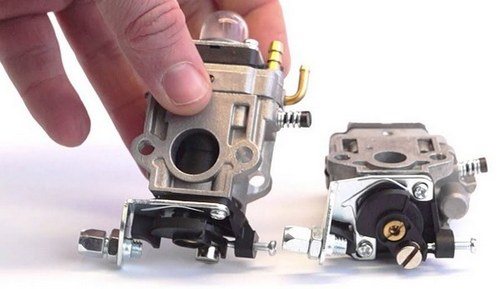
Having an idea of how the carburetor works inside, you have to understand the principle of its operation. A detailed description of how a carburetor works on a two-stroke internal combustion engine using the example of a chainsaw is described in this material.
How to adjust the carburetor on a lawn mower
The upcoming adjustment of the lawn mower carburetor is done with your own hands using adjusting screws. There are three in total:
Right (L) – adjusting the fuel consistency for low speeds.
It is necessary to find the highest idle speed. To do this, slowly unscrew the screw (L) to the right and to the left.
To adjust, turn the screw a quarter turn, always counterclockwise.
Bottom (T) – is responsible for adjusting the engine at idle.
- clockwise – increase;
- counterclockwise – decrease.
For correct adjustment of idle speed specifically:
- stable operation of a cold engine;
- not over-revving a hot engine;
- there is a large reserve of revolutions for the trimmer head;
- stable operation of the engine when changing position (sharp raising or lowering of the knife).
Left (H) – mixture adjustment at high speeds. (The screw is adjusted last).
The overall adjustment of maximum speed, engine power, temperature and gasoline consumption depends on the left screw (H).
Setting up the carburetor of a lawn mower with the last screw is done as follows:
- Open the throttle to full, while releasing full throttle. Turn the screw clockwise until the speed drops (in this case, use your ear).
- Turn the screw as slowly as possible counterclockwise until the engine runs rough.
- Then turn back just a little, barely hearing stable, smooth operation.
- For a more visual application of skills, it is more convenient to consider the work of an experienced user:
It is interesting that from the point of view of the author of the video, the setting (its correctness) is determined by the color of the spark plug, and not just by the engine speed and stability.
with your own hands
Post Views: 10
Adjusting the carburetor trimmer
The initial step in restoring proper operation of the fuel system is to clean the air filter.
Trimmer carburetor with screws
Experts recommend washing it in a solution of water and detergents after every 10-15 hours. Direct adjustment of the trimmer carburetor is performed using three adjusting screws:
- fuel adjustment screw (“L”);
- high speed adjustment screw (“H”);
- the screw responsible for idling the engine (“T” or “AT”).
Adjusting fuel supply at minimum speed
Before you start adjusting the gas trimmer carburetor, you need to warm up the engine to operating temperature.
Fuel adjustment screws
To do this, start the internal combustion engine and let it run at idle speed for 10-15 minutes. At the first stage, with the trimmer running, slowly tighten screw “L” until intermittent operation begins or until it stalls. Next, unscrew the screw ¼ turn and check the speed of reaching maximum speed. If the lawn mower easily and quickly reaches high speeds, this will be the most economical mode. In most models on the market, the fuel supply screw “L” is tightened clockwise, however, there are trimmers where the reduction and increase in the flow of the mixture occurs in the reverse order.
Setting trimmer idle speed
Location of carburetor adjustment screws
The “T” (“AT”) screw serves as a limiter for the reciprocating movement of the fuel valve and when it is tightened, the engine speed increases, and when unscrewed it leads to a decrease in the crankshaft speed. Professionals advise adjusting the idle screw of the lawn mower so that the internal combustion engine operates a little faster at minimum speed, but the head with the fishing line or knife remains motionless. If after these manipulations it is difficult to start the trimmer “cold”, then just tighten the “T” screw a quarter turn and try to start the engine again.
Adjusting the maximum speed screw of the brush cutter
After restoring the fuel supply to minimum speed and adjusting the idle speed, it is necessary to check the stability of the mechanism at increased speed.
Setting at maximum speed
Adjusting the motor at high speeds is carried out to protect against overheating and reduce hand fatigue when pressing the accelerator button. If the internal combustion engine operates unstable at maximum speed, then screw “H” must be tightened slowly until smooth and precise operation is ensured.
During operation of the brush cutter, it may be necessary to adjust the fuel supply screw (“L”) for optimal speed.
How does a lawn mower carburetor work or its operating principle?
Adjusting the carburetor of a Chinese lawn mower is completely identical to the adjustment of lawn mowers from European, Russian and other manufacturers. To cope with the task of adjusting the carburetor on lawn mowers and gas trimmers, you need to understand the principle of their operation. How a carburetor works on a lawn mower is described step by step and in an accessible manner below.
- The operation of the lawn mower carburetor begins with the supply of fuel through the channel, as shown in the diagram
- Fuel is sucked into the carburetor using a pulse channel connected to the engine crankcase. Due to rarefaction of air, the flexible membrane at number 4 in the diagram above moves
- Fuel is supplied through valves 3 and 5. Valve 3 is an inlet valve, due to which fuel is supplied to the sub-membrane space, and valve 5 is an outlet valve
- Next, the fuel moves along the channel and, passing through a fine filter, reaches the needle valve 14
- The needle valve is connected via a lever to the control diaphragm 18
- The needle valve is activated by pressure on the membrane. When it is necessary to pump up fuel to start the engine, it is necessary to operate the soft cover of the hand pump. When exposed, the needle opens and the chamber is filled with the fuel mixture
- When the engine starts (cold), the needle opens due to vacuum when the air damper is closed. This vacuum acts through the idle and high speed jets on the membrane 18
- The membrane acts through a lever on the needle valve, thereby filling the chamber
- After starting the engine, the air damper opens, causing the engine to run lean as fuel mixes with air.
- When the chamber is full, the fuel mixture is supplied (sucked in) through the idle and medium speed jets (when the engine is running)
- The throttle valve is shifted from its original position by 10-15 degrees
- When work is carried out under load, fuel begins to flow into the chamber through the high-speed nozzle, and at the same time the throttle valve rotates at an angle of up to 90 degrees (depending on the force of pressing the gas). In all operating modes, the air damper must be open, through which the fuel is mixed with air, thereby igniting the mixture in the cylinder
Below is a diagram of the operating principle of a lawn mower carburetor. Based on the diagram, you can not only understand the principle of operation, but also identify breakdowns and other malfunctions of the mechanism.
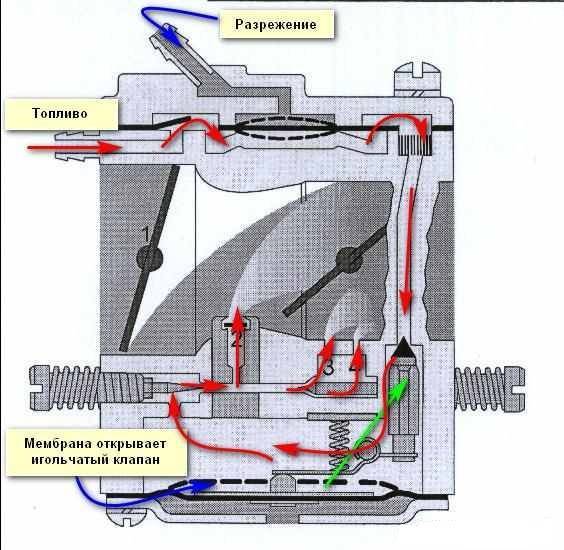
When operating the tool, it is necessary to take into account the presence of another jet. This jet is located between the idle and full power passages. It is necessary in order to avoid severe leaning of the mixture, which occurs when the engine operates at partial load. In such a situation, the occurrence of a bullying couple cannot be ruled out. Through an additional channel (nozzle), fuel is sucked into the chamber, thereby enriching the fuel-air mixture. The diagram below shows an additional jet, which is designated by the number 1.
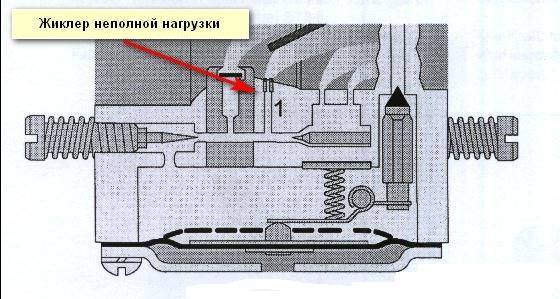
Having an idea of the design of the diaphragm carburetor of a brush cutter and the principle of operation, it will not be difficult to configure it yourself. To adjust the carburetor of a lawn mower, adjusting screws are used. The diagram above shows two screws for adjustment, however, most modern models of gasoline trimmers are equipped with three screws. The presence of three adjustment screws allows for more precise adjustment, while achieving stable and uninterrupted operation of the internal combustion engine.
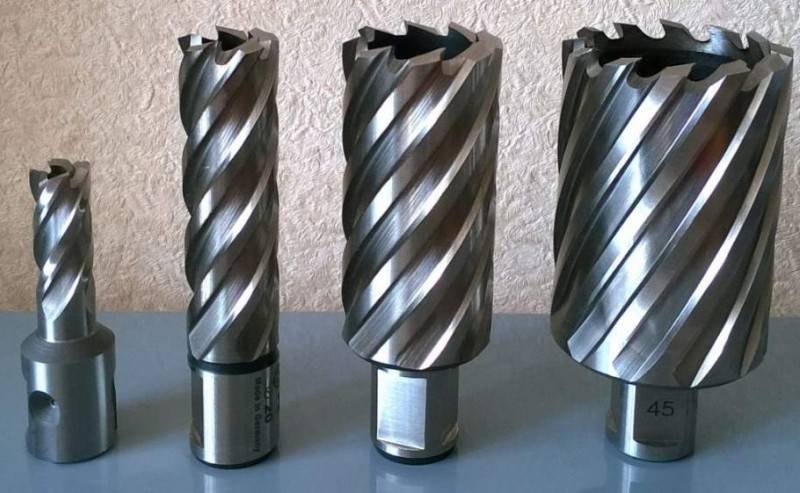
This is interesting!
What is the difference between a trimmer and a lawn mower? Many people think that trimmers are low-power electric lawn mowers. However, trimmer is a generic name for gas trimmers, walk-behind trimmers and electric mowers as they are designed for a common purpose.
Quick start of the unit
- We place the tool on its side so that the air filter is on top. In this arrangement, it is possible to ensure that the fuel mixture reaches the very bottom of the carburetor. The engine can start on the first try if you remove the air filter before starting and pour a small amount of the mixture into the carburetor (a few drops are enough, and don’t get too carried away), and then install the recently removed parts back. This method has been tested in practice and works in most cases. Surely many owners of an old domestic car used a similar method on their car. The principle with the scythe remains absolutely the same.
- If the first advice does not bear fruit, then you need to unscrew the spark plugs and look at them carefully. We unscrew the spark plug, check its functionality, and then dry the combustion chamber. A candle that shows no signs of life must be thrown out and a new one installed. If everything is in order with the old one, then we put it in place and move on to the next method.
- If the spark plug is fully operational, the filter is clean, and the fuel mixture is fresh, then you need to resort to a universal method of starting the lawn mower. It is worth closing the carburetor choke and pulling the starter handle once. Then open the damper and pull the starter about 3 more times. This procedure is repeated 3 to 5 times. The engine should start. But you shouldn’t pull the handle too hard, because in this case you will also have to repair the starter of the lawn mower. This will only be needed if the cable breaks or the handle breaks. In other cases, it is recommended to replace the starter immediately. This unit is sold completely assembled.
- There is also a very simple way to get a braid. Many people forget to press the gas choke after filling the fuel mixture. It is usually located near the gas tank. On a household mower, it looks like an ordinary ball of air, which must be pressed 5-10 times for the mixture from the tank to go as intended. In most cases, this option works flawlessly. You just need to help the fuel flow through the channel.
Correct replacement of spark plugs
Many people know that spark plugs should be changed periodically, but few do it correctly and in a certain sequence. To perform all the manipulations correctly, you should familiarize yourself with the correct procedure.
This is interesting: Do-it-yourself repair of the starter retractor relay
- Stop the engine and wait until it is cold, otherwise you may be seriously burned.
- Disconnect the high-voltage wire from the spark plug. We unscrew the spark plug using a special wrench. We examine the candle.
- The part must be replaced if it is in poor condition, very dirty, or if a crack is found on the body.
- Check the gap between the electrodes. Their size should be 0.6 mm.
- We install a new spark plug and tighten it with a wrench.
- We install a high-voltage wire on the central electrode of the spark plug.
There is nothing complicated in this procedure , and absolutely any owner of a gasoline scythe can cope with it.
The lawn mower stalls after starting
The engine may stall after starting the device if the carburetor is not configured correctly or is misadjusted.
It's very easy to identify. Vibrations may occur and are clearly felt during operation. You can make the adjustment yourself; you should strictly follow all the instructions written in the manual. The engine may also stall due to a clogged fuel valve . In this case, it must be cleaned, and then the problem will be eliminated.
If the scythe starts up and then suddenly stalls, this means that the supply of fuel to the carburetor is difficult. It is necessary to loosen the carburetor valves , then the free flow of fuel to it will be carried out in the required quantity.
If there is excessive air leakage, then the engine may also stall. You should increase the speed a little so that air bubbles come out of the fuel system. It is also worth checking the integrity of the fuel intake hose. If any damage is found in it, the part must be replaced immediately.
The principle of operation of a lawn mower carburetor
The throttle valve determines the amount of air supplied, and engine power directly depends on this.
Fuel is sucked into the carburetor system by a pump (its membrane). Then it passes through the fitting in the carburetor. The liquid then moves through the inlet and outlet valves of the pump. Filtered with a mesh. It moves along the needle valve into the membrane chamber.
Step-by-step operation of the device:
- Air supply into a tube with an air baffle (damper). The partition regulates the intensity of the air flow.
- The fuel supply system is necessarily narrowed with a diffuser to increase the flow rate.
- Gasoline through the float chamber and the nozzle tube with a narrowing. A chamber with a float regulates the temporary volume of gasoline. In the float chamber the pressure level is neutral, and in the tube with a narrowing it is already low. Due to the pressure difference, fuel penetrates through the nozzle.
- Accelerating air flow promotes the transfer of fuel (gasoline) and its atomization. As a result, an air-fuel mixture of the required proportion or density is formed.
- The air-fuel mixture enters the engine cylinder through the fuel pipe.
The level of air density in the system depends on the area of the open air damper. The wider the throttle is open, the greater the fuel consumption and power.
Simply put, carburetor adjustment
on a lawn mower – creating an optimal fuel mixture due to the correct air supply.
What types of breakdowns happen and how to recognize them?
One of the problems with trimmer engine failure may be the strainer. Only two breakdowns can be attributed to this element:
- Accumulation of dust and dirt.
- Partial or complete breakdown.
To identify the exact cause, you need to do the following:
- Unscrew the fuel air lock cap to remove the strainer. If dirt is found on a part, wash it in fuel or blow it thoroughly. If you see any serious damage to the strainer housing, don't hesitate to install a new one.
- If the compressor fuel supply pipe is broken, this part should be checked. Most often, it requires periodic replacement due to its low strength.
- To clean the starting part of the carburetor from blockages, you need to use acetone or gasoline. You can also blow out the components of the device with compressed air - this is the easiest and most convenient way to repair.
Important! The base of the throttle valve, intake and exhaust valves, and the joints of all parts of the carburetor can be checked by a simple action - lubricate the problem area with soap foam.
Basic problems
Malfunctions of the carburetor of a lawn mower or trimmer, despite the relative ease of their elimination, sometimes require a long search by elimination. The main reasons are:
- unsatisfactory quality of gasoline purification;
- air filter clogged;
- accumulation of deposits and carbon deposits in the compartments and passages of the carburetor.
Each of the problems has its own reasons.
Fuel injector malfunction
The most recurring failure is wear and tear of the membrane. As a result, its non-adherence. Fuel passages are not sealed at certain stages of the engine cycle. The reasons here are:
- you work for too long on a lawn mower or trimmer without a break;
- low-quality fuel was filled;
- exhaust gases enter the pulse channel.
A deformed membrane has several bad consequences:
- there is not enough gasoline or oxygen in the created combustible mixture;
- the engine starts after 10 or more unsuccessful attempts;
- the engine knocks, clatters during operation, etc.;
- the working piston is deformed.
Strainer clogged
The reasons for a clogged strainer are poor fuel cleaning, damage to the hose and/or injection head.
Failure of the adjustment lever
Wear of the contact edge of the lever is a consequence of incompletely purified fuel, which contains grains of sand or particles of clay, metal, or other inclusions that are insoluble in liquid hydrocarbons. A problem appears with fuel injection; the engine operates intermittently without load.
Inlet needle is damaged
The inlet needle breaks due to the presence of metal and stone particles in gasoline. As a result, the intake needle seat does not fit tightly to it, and the fuel mixture flows. There is too much air in the combustible mixture created by the carburetor, which can cause the engine to “sneeze” during operation. Finally, the needle may become stuck due to low-quality gasoline, or the unit has been idle for a long time.
Clogging of the adjustment space
Deposits may accumulate in the adjustment compartment. The needle does not close the hole completely, and a lot of gasoline enters the fuel chamber - the engine overflows it, possibly flooding the spark plugs. Because of this, the gasoline-air mixture contains an increased amount of gasoline vapor. The efficiency drops noticeably.
The adjustment membrane is damaged
The membrane often becomes deformed (and sometimes breaks) due to the continuous operation of a lawn mower or trimmer for several hours. If you abuse this “impact” mode of operation, damage to the membrane occurs more often. New breakdowns will rain down like from a cornucopia:
- the piston breaks;
- the number of attempts to unsuccessfully start the engine will increase sharply;
- the fuel mixture will contain too little gasoline;
- The useful (thermal) power will drop sharply.
Intake control lever sticks
Sticking of the adjustment lever is a consequence of its incorrect installation or accidental bending. The contacting edge will be in the wrong position. This will disrupt the additional injection of gasoline.
The valve is worn out
The throttle and air dampers become unusable due to the entry of dust, metal particles, etc. with the air flow. Damaged dampers look like parts that have been sand blasted. Due to wear on the dampers, the efficiency of the motor decreases and breakdowns are detected. The piston and cylinder wear out.
In some cases, this filter is simply not suitable for your model of lawn mower or trimmer. Ultimately, the motor shaft will suffer - pieces of it will fall into the engine channels, causing the piston to break.
Carburetor cannot be adjusted
The springs on the adjusting screws are to blame for the fact that the adjustment is too rough (it is not possible to set the parameters accurately). The manufacturer of a brush cutter or trimmer may supply excessively thick and stiff springs. You can find others either in workshops where similar equipment is repaired, or purchased from any dealer or official representative of the company that produced the motor for your trimmer or mechanical scythe.
The primer is broken
Primer is a manual mini-pump for forced pumping of fuel into the carburetor. To successfully start the engine, you may need to pump 20 ml of gasoline manually.
Common carburetor malfunctions
Trimmer carburetor breakdowns occur due to the use of poor quality gasoline, a damaged air filter, and the accumulation of dirt in the chamber of this unit. Most often, it is quite possible to repair a carburetor yourself. Listed below are typical problems with the carburetor of a brush cutter.
Fuel pump problems
A common malfunction that “haunts” the fuel pump is deformation of the pump membrane. For this reason, it does not seal properly and the pump channels do not seal.

The reasons for membrane deformation may be the following:
- long-term trimmer operation;
- use of unsuitable fuel;
- entry of gases into the pulse channel.
As a result, damage to the membrane reduces pump performance, and as a consequence:
- the combustible mixture becomes depleted;
- it is difficult to start the engine;
- there are interruptions in the operation of the motor;
- the piston is damaged.
Also, the above-described consequences for the engine can be caused by clogging of the pump cavity on the impulse side. In this case, dirt enters the membrane through the pulse channel.
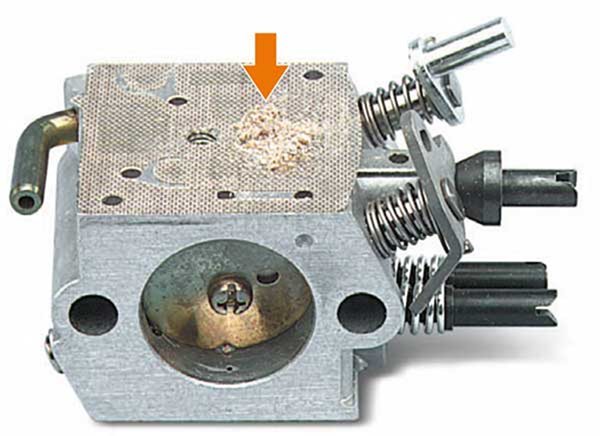
To remove the blockage, you will have to disassemble the carburetor and clean the membrane.
Strainer clogged
The strainer can become clogged when contaminated fuel enters through a fuel hose or a defective suction head. In the photo below you can see what a clean filter looks like and a dirty one (the parts are separated by a line).
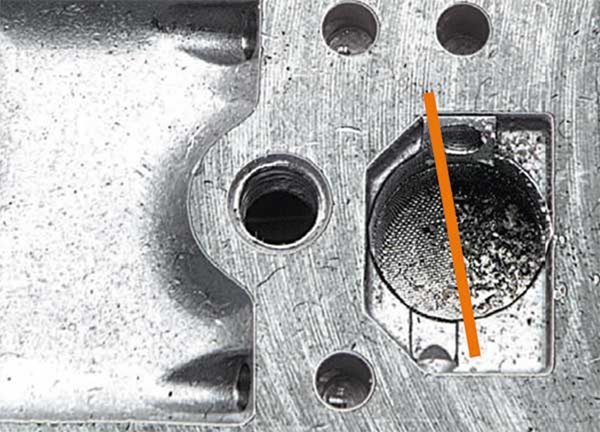
To eliminate the problem, you will need to thoroughly clean and rinse the strainer. It is also recommended to blow out all the holes in the trimmer carburetor body with compressed air.
The adjustment lever is faulty
This breakdown occurs when the contact surface of the lever wears out.
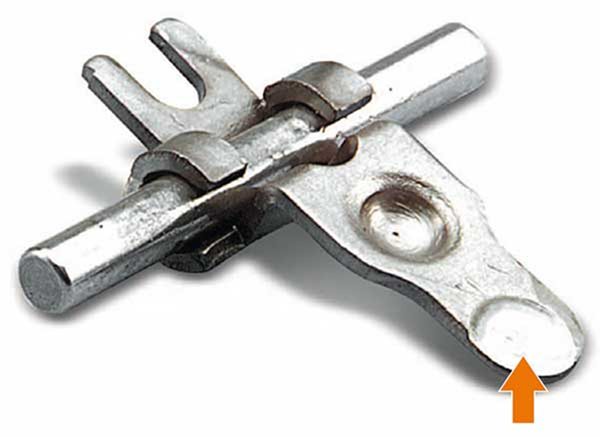
Abrasion of the contact surface occurs due to the presence of abrasive particles in gasoline or due to strong vibration of the engine during operation. This defect in the adjustment lever causes problems with intake, as well as improper operation of the engine at idle.
Inlet needle wear
The inlet needle fails, usually due to the presence of abrasive particles in the fuel fluid.
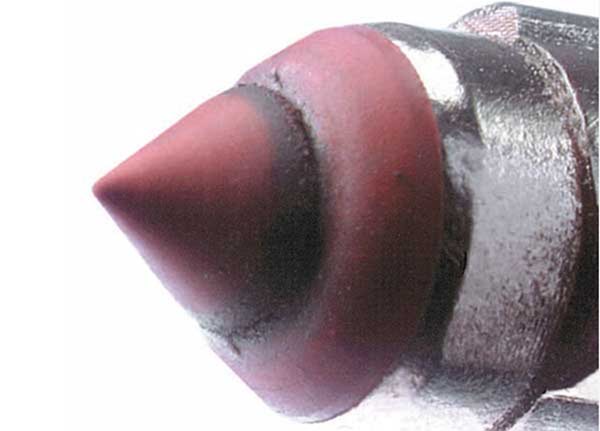
As a result:
- the tightness of the inlet needle seat is disrupted;
- leakage of the flammable mixture appears;
- Engine malfunctions appear due to over-enrichment of the fuel mixture.
Also, the inlet needle may simply jam.
Sticking of the inlet needle can cause dirt in the fuel, or the device may remain idle for a long time.
Clogged adjustment cavity
If dirt accumulates in the adjustment cavity, the inlet needle cannot tightly close the hole and a lot of fuel pours into the chamber.
This causes the fuel to become over-rich and the engine starts to operate incorrectly. It is necessary to disassemble the carburetor and clean the cavity of the adjusting membrane.
Deformation of the control membrane
The membrane may be subject to deformation during prolonged operation of the unit and when using aggressive fuel.
The impossibility of normal adjustment due to a defect leads to:
- piston damage;
- difficulty starting;
- fuel depletion;
- improper engine operation.
Intake control lever problem
This problem can occur if the adjustment lever is not installed correctly or if it is bent before installation. As a result, the contact surface takes an incorrect position, which disrupts the additional fuel supply.
Damper wear
The throttle and choke valves mostly wear out due to abrasive particles in the air. Defective dampers look as if they have been sandblasted.
As a result of wear on the valves, engine performance decreases, malfunctions appear in its operation, and the piston rings, piston and cylinder coating wear out.
Worn throttle and choke shaft
The air and throttle valve shaft may wear out due to the following reasons:
- insufficient and improper maintenance of the air filter;
- the air filter is damaged;
- The air filter is not suitable for this unit.
Due to the entry of poorly purified air, the shaft wears out and may break. Broken shaft parts can enter the combustion chamber or crankcase and cause serious damage to the entire piston system.
To eliminate problems with air purification, it is necessary to replace the defective filter or rinse the existing (functional) one. The filter must be washed in soapy water and dried.
Carburetor design
A petrol mower (motor mower) contains a base - an aluminum body, which houses the remaining parts that work harmoniously as a single whole. The carburetor body has a diffuser - a passage with internal channels through which air is pumped.
Channels branching from the diffuser deliver fuel, with which the injected air is mixed, carrying gasoline vapor with it. Outside the main compartment of the carburetor are located:
- jets;
- mini fuel pump;
- a unit that regulates the mixing of fuel with air.
The latter forms that very explosive mixture that ignites in the combustion chamber of the carburetor.
Adjusting the Husqvarna carburetor
Before adjusting the Husqvarna, do maintenance on the trimmer (wash the trimmer and engine, replace the spark plug, eliminate minor defects).
Be sure to wash the foam air filter element. Wash the element in warm water and soap, then wring out and dry (or replace if it is old or damaged).
Note: If you adjust a Husqvarna carburetor with a dirty air filter, the fuel mixture will become much leaner after cleaning the air filter (which can lead to poor performance or even engine failure). Install a trimmer head with the maximum permissible diameter and standard length of cord (up to the cutting blade in the additional protection) to create a load on the engine when adjusting the high speed screw of the Husqvarna carburetor. Start the trimmer according to the Husqvarna Manual and warm it up for 10 minutes (if the trimmer head rotates at idle speed, then the idle speed screw, i.e.
the bottom one must be turned counterclockwise until the rotation of the trimmer head stops). Carefully turn both needles (right and left) to the middle position between fully unscrewed and fully screwed in (do not turn by the stopper!, this may cause damage to the Husqvarna engine)
There are three adjusting screws for adjusting the Husqvarna carburetor: right, left and bottom.
1) Right screw L - adjusts the enrichment of the low speed mixture (adjusted first): Find the maximum idle speed by slowly turning the right screw to the right and left. Then turn this screw ¼ turn counterclockwise. Note: From the Husqvarna factory the right hand screw was turned out completely (0.5 turn). Now he is looking at 11 o'clock. 2) Lower screw T - adjusting the idle speed of the Husqvarna engine (if necessary): turning the screw clockwise increases the idle speed, counterclockwise decreases it.
The idle speed adjustment is considered correct when:
- A cold engine idles steadily.
- A hot engine does not idle too high.
- Before the trimmer head starts rotating, there is a sufficient reserve of revolutions.
- The engine operates stably in any position (for example, when the knife is sharply lowered).
Note: From the factory (Husqvarna), the idle screw was turned from fully tightened to 8 full turns and “2 o’clock” (now it remains so). The recommended idle speed of the Husqvarna lawn mower engine is 2,900 rpm. 3) Left screw H – regulates the enrichment of the mixture at high speeds (adjusted last). It regulates maximum speed, engine power, temperature and fuel consumption.
Note: The Husqvarna engine should not be run at full speed for more than 10 seconds!
- Open the throttle fully (full throttle) and slowly turn the left screw clockwise until the Husqvarna engine speed is reduced (audibly).
- Then turn the left screw very slowly counterclockwise until the engine starts to run rough.
- After this, turn the screw slowly back a small distance clockwise until the Husqvarna engine starts to run smoothly.
This completes the Husqvarna adjustment.
Note: The recommended maximum speed of the Husqvarna engine is 11,500 rpm. The maximum engine power output of the Husqvarna 333R trimmer is 1.6 kW (2.1 hp) at 8,400 rpm.
Note: On a new Husqvarna trimmer from the manufacturer (Husqvarna), the left screw was completely unscrewed (0.5 turn) and blocked (filled) with hard plastic, which I drilled out after the warranty expired. Now the left propeller (like the right) is pointing at approximately 11 o'clock.
Checking the correct settings of the Husqvarna carburetor
The engine revs quickly, smoothly and confidently, and revs a little at maximum speed; the T-35 trim head should not rotate at idle.
How a carburetor gas trimmer works and works
It is almost impossible to cover all types of carburetors produced by gas trimmers. But since the design of this module, as well as the principle of its operation, are largely similar between different models, it is possible to generalize the description of the processes occurring in the carburetor. This information will allow the user to understand the operation of the device, troubleshoot problems, and operate it correctly.
The basis of the carburetor trimmer is an aluminum body. Below is a diagram of this device.
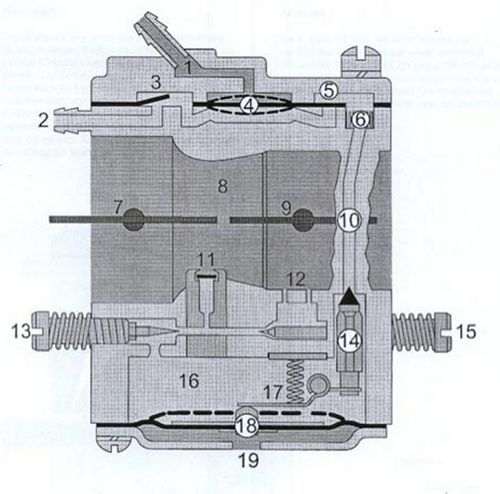
At the bottom is a diffuser, also called a Venturi nozzle (18). Air is sucked in by the engine through this nozzle.
In the upper part of the diffuser there are fuel channels (11,12). Through these channels, the air flow enters the gasoline. The fuel pump itself, the injectors and the system used to control the flow of the air-fuel mixture can be built-in or externally mounted.
The throttle (9) regulates the amount of air entering the carburetor. Its amount affects the power developed by the engine. Valve (7) is used for cold starting. You need to close it if you plan to start the device. After starting the engine, it must be opened, otherwise the engine will freeze immediately.
The pulse channel (1) connects the pulse chamber of the pump to the crankcase, namely to its internal volume. The piston located in the cylinder, performing a reciprocating movement, consistently changes the pressure in the crankcase (increasing vacuum or pressure). The pressure drop causes the membrane (4) to move. Therefore, the pump is synchronized with the engine.
It is with the participation of gasoline that the membrane (4) flows out of the tank. Gasoline enters the carburetor through fitting (2). Next, its path passes through the inlet valve (3), exhaust valve (5), through the strainer (6), fuel channel (10), passes through the needle (14) and fills the chamber (16), which has a control membrane (18).
The valve (14) is connected to the membrane (18) via a lever (17). The cavity, which is located below the membrane, is connected to atmospheric air through an opening (19).
The device works as follows.
- During suction, a vacuum is created in the diffuser. This fact causes air leakage. The position of the throttle valve (9) determines the amount of air entering the carburetor chamber, as well as the power and speed of the engine.
- At this time, fuel from the chamber (16) is sucked through the nozzles (11, 12) and then mixed with the air flow. Gasoline mixed with air begins to atomize. This is how the air-fuel mixture is created.
- The finished mixture enters the cylinder, where it is compressed by the riser piston and ignited at the correct point by a spark generated by the spark plugs.
- Since the volume under the control membrane (18) is connected to atmospheric air through the channel (19), the membrane rises upward, opening the valve (14) using the lever (17). After opening the valve (14), the new fuel chamber enters the chamber (16).
- Once the chamber (16) is full, the membrane (18) returns to its original position and the valve (14) closes.
READ Adjusting the Carburetor of the Oleo Mak 937 Chainsaw
Then, when the engine is running, all the above processes are repeated. Screw (13) is used to regulate the amount of fuel entering the diffuser through the injectors. Screw (15) is also used to adjust the idle speed. When the regulators are turned, the fuel mixture becomes richer, and when the regulators are turned, the mixture becomes lean. Also, on some carburetor models, you can adjust the engine idle speed. Quantity regulator. It is usually located externally and, when twisted, rests on a lever mounted on the throttle shaft.
Thus, with the help of 3 adjusting screws, you can achieve maximum engine performance and also adjust its smooth operation in any ambient temperature and even in mountainous areas.
Reference. Read to understand what you are doing!
The required composition (quality) of the air-fuel mixture is adjusted (changed) by turning the screws for adjusting the fuel supply to the intake air flow (right and left). The amount of mixture entering the cylinder is dosed by the throttle valve. If they are turned clockwise, the mixture sucked into the cylinder becomes leaner (less fuel in the air/fuel ratio) and the engine speed increases, while the Husqvarna engine runs softer (weakly picks up speed) and the power drops significantly. In addition, at higher speeds, less oil and gasoline enter the cylinder with a lean mixture (worse lubrication), and this can cause the engine to spoil. Well, the trimmer will have trouble starting. If the screws are turned counterclockwise, the mixture sucked into the cylinder becomes richer (more fuel in the air/fuel ratio) and the engine speed decreases, while at low speeds more gasoline and oil enter the cylinder (better traction, better lubrication), but the Husqvarna engine “spins up” poorly (does not pick up speed well) and more carbon deposits form in the cylinder!
Tips for repairing a gas trimmer carburetor
Regardless of the manufacturer, there are factory defects in trimmer carburetor parts.
For example, the adjustment method described above may not give positive results if the number of turns of the mixture supply screw spring is too large and, as a result, it is impossible to optimally reduce the level of gasoline supplied. To eliminate this, you can shorten the spring yourself a little or purchase a new one in accordance with the instruction manual.
When purchasing oil, many owners of lawn mowers follow the recommendations for preparing the fuel mixture indicated there.
So, often the information on mixing gasoline and oil indicated on the can differs from the instructions in the trimmer's passport. As a result, black carbon deposits can quickly form on the spark plug, which leads to a drop in power and increased fuel consumption. Therefore, when preparing the working mixture, you should follow the recommendations specified in the instruction manual. In most cases, the proportion for a run-in internal combustion engine is 1:25. It is worth noting that many tool owners prefer to prepare fuel “by eye,” which will certainly lead to rapid wear of the piston scythe if the oil portion is reduced and the formation of soot on the spark plug with an increased amount of lubricant.
Correctly performed above tips for setting up the trimmer carburetor will help to avoid not only engine overheating and increased fuel consumption, but will also significantly increase the service life of other parts and components of the tool
Pay attention to the operation of the lawn mower in all modes and carry out scheduled maintenance and repair of the tool on time.
From personal experience
Petrol mower or trimmer
Trimmer. This is a broader concept than a gas scythe because it can also be electric. Gas trimmer and brush. It is the same.
Some authors argue that the trimmer is a weaker tool compared to more powerful hedge trimmers that can be used to mow bushes. Personally, I have a tool with a maximum power of 1.7 kW, and I can mow a small bush up to 10 mm thick, as stated in the instructions. The user manual is called "Gasoline Trimmer."
Fuel mixture proportion
I read somewhere that if the motorcycle and oil instructions may indicate different fuel mixture ratios, you should use the ratio specified in the manual.
This has been the case for a long time. Excess oil flowed from the engine into the gas tank, and soot was constantly forming on the spark plug, because the instructions indicate a ratio for engine operation of 1:25 and a canister. 1:50. Has stopped. The spark plug continued to burn, but with less intensity (the carburetor had not yet been adjusted).
Until now, some users of gasoline tools determine the proportion of the fuel mixture “by eye.” If the amount of oil is underestimated during the preparation of the mixture, after some time, immediately after starting the engine, a strange sound may appear, gradually disappearing during warm-up, and the engine stops abruptly. Continuing to operate the trimmer in this mode will result in its failure.
Model description
The above-mentioned equipment option costs RUB 13,490. It is a premium device. With its help, you can take care of the territory on a large suburban site. The equipment can handle young and old grass, reeds and weeds, as well as young bushes.
The petrol mower "Stil FS 55", reviews of which you can read below, has a powerful 1 liter engine. With. The device is ideal for use in a suburban area or country house. In one pass you can mow 420 mm of grass in width. This device is suitable for hardware processing of the lawn, mowing grass and allows you to even walk along fences, process narrow areas and areas near flower beds. The tank holds 0.33 liters of fuel, which will be enough for uninterrupted operation for half an hour.
Elimination methods
The list of upcoming work on the engine may be as follows:
- replacing the fuel pump;
- disassembling and washing the strainer;
- replacing the adjustment lever;
- it is also necessary to clean the adjustment space;
- replacing the membrane (or the entire block where this membrane is located);
- adjusting intake, exhaust and needle valves;
- replacing dampers;
- cleaning fuel channels and diffuser;
- replacing screw springs;
- change of primer.
Not all of these jobs can be completed. It often turns out that many of them are not needed if a specific malfunction is immediately detected.
Main problems and malfunctions of the carburetor.
Grid There are only two problems with this element:
- Clogging.
- Violation.
To determine the cause of the problem, unscrew the fuel filter cap to remove the strainer. If dirt has simply accumulated on it, washing with gasoline or blowing it out will help.
Be sure to install a new filter if there is any visible damage. There may also be damage to the fuel line (check this point during repair).
In most cases, the carburetor starter does not work due to blockages. For washing, use acetone or the same gasoline.
Blowing clogged air through carburetor parts is an acceptable and convenient repair practice.
Petrol mower device
The structure of the Shtil FS 55 lawn mower should be clear to you if you plan to operate the equipment, and even more so to repair it. The internal combustion engine in this unit is almost the same as in a chainsaw. But the last tire is fixed to the motor gearbox with a long tubular rod. Inside there is a shaft that transmits torque from the motor to the working tool. This design is suspended on a belt that is thrown over the shoulder. This allows you to hold the tool suspended, which is important when the weight of the chainsaw is sensitive.
A handle is fixed to the rod of the unit, with the help of which you can move the end of the rod with working equipment. The petrol mower "Stil FS 55", a repair manual for which is presented in the article, has a protective shield on the human side in the form of a casing, which prevents injuries during operation. The instrument itself is a round drum with a thick fishing line coming out of holes on both sides of it. Adjusting the carburetor and chainsaw repairing lawn mowers Stihl fs55 fs 38 carburetor. When the drum spins, the line is pulled under the influence of centrifugal force and hits the grass, cutting it.
The Shtil FS 55 petrol mower, the technical properties of which will be presented to your attention below, has a fast-wearing nylon line. Features of the Stihl fs 38 lawn mower, adjusting the carburetor of the Stihl fs 38 lawn mower. It is sometimes updated by the method of unwinding the coil, which is located inside the drum.
How to setup
Before adjusting the carburetor trim, do the following:
- Flush the engine;
- Replace or clean the spark plug;
- Replace it with a new one or clean the air filter (it is recommended to wash it in warm soapy water, wring it out and let it dry well).
It is also necessary to install a cord of a suitable diameter in the trimmer coil or install knives - this is done so that during the adjustment process the engine has at least some load. After installing the cutting tool and starting the gasoline engine, allow it to warm up for 10 minutes.
If at idle you notice that the cutting tool is rotating, so you need to reduce the engine speed. This is done using the lower idle control, often marked with a "T". The picture below shows the location of the handles on a Husqvarna trimmer.
But, for example, on a Stihl trimmer this screw may be marked “LA”.
Therefore, turn the idle control to the left until the trimmer head comes to a complete stop.
3 adjusters (screws) are used to adjust the carburetor.
- The right handle L regulates the level of enrichment of the fuel mixture at low speeds. This must first be corrected. Get maximum idle speed. This is done using the L knob by turning it left and right. When you find the maximum speed point, turn the knob half a turn to the left (counterclockwise).
- Lower T-Handle (LA) Used to adjust idle speed. Turning to the left will reduce the engine speed, and turning the knob to the right will increase the speed.
- The left handle H is responsible for enriching the fuel mixture at high speeds. The enrichment parameter completes the carburetor adjustment. You can also use this controller to adjust the maximum speed, fuel consumption and engine power.
READ How to Lubricate the Shaft in the Huter Trimmer Bar
An adjustment will be required to resolve this issue. With the engine running, apply full throttle, then turn the "H" handle to the right until the speed decreases. Then slowly turn the H control to the left until you hear the engine running unevenly. Then turn the “H” knob to the right until the engine runs smoothly.
After completing the above steps, the carburetor adjustment can be considered complete. Once properly adjusted, the engine should reliably reach four speeds at maximum speed, and the cutting tool should not rotate at idle. This guide is suitable for tuning carburetors on Huter, Patriot and others.
These are also screwless carburetors, responsible for enriching the combustible mixture at low speeds. That is, they have only 2 adjusting screws: the idle speed regulator and the fuel mixture quality regulator at high speeds. You can learn how to tune this type of carburetor from this video.
Source
Gas cutters, like all gas-powered garden tools, are not easy to maintain. You can and should repair and adjust yourself. For example, self-control of a carburetor using a homemade brush is a matter of five minutes.
The brush cutter carburetor is a component in the power system. In it, as in any carburetors, the process of mixing air and fuel (gasoline) takes place for subsequent supply to the engine cylinders.
